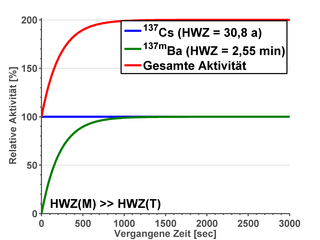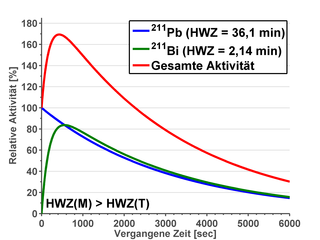Secular balance
The term secular equilibrium or permanent equilibrium comes from nuclear physics and describes a relationship between the activities of radionuclides within a decay chain or during the production of artificial radionuclides. Above all, one speaks of radioactive equilibrium .
If the half-life of the mother nuclide is significantly longer than that of the daughter nuclide, then the activity of the daughter nuclide approaches the activity of the mother nuclide over time. If both activities are equal, secular equilibrium is reached, since in this state the parent nuclide always delivers just as many nuclides of the daughter nuclide as there are daughter nuclide nuclei in the same period of time.
The decay product (“daughter nuclide”) of many radionuclides is itself radioactive again; this can - as for example with the primordial isotopes of uranium and thorium - span several generations and lead to even more complex situations.
Possible equilibria
- Secular balance
- T mother ≫ T daughter : the activity of the daughter nuclide asymptotically adjusts to the activity of the mother nuclide.
- Transient equilibrium
- T mother > T daughter : the activity of the daughter nuclide reaches the activity of the mother nuclide at the point of its maximum activity and overtakes it. The ratio of the two activities asymptotically reaches T mother / (T mother - T daughter ).
In the example 211 Pb ⇒ 211 Bi this value is 1.063. - Out of balance
- T mother ≲ T daughter : Here too, the activity of the daughter nuclide at the point of its maximum activity reaches the activity of the mother nuclide and overtakes it. If the half-life of the mother nuclide is approximately the same or if it is shorter, the ratio of the two activities increases continuously and no longer reaches an equilibrium (if T mother ≤ T daughter , otherwise at least within the scope of observability).
In the example 214 Pb ⇒ 214 Bi, this value is mathematically 3.94, but when the value 3.77 is reached, 99.99% of the mother nuclide has already decayed. In this example, the state of equilibrium is calculable, but not observable.


